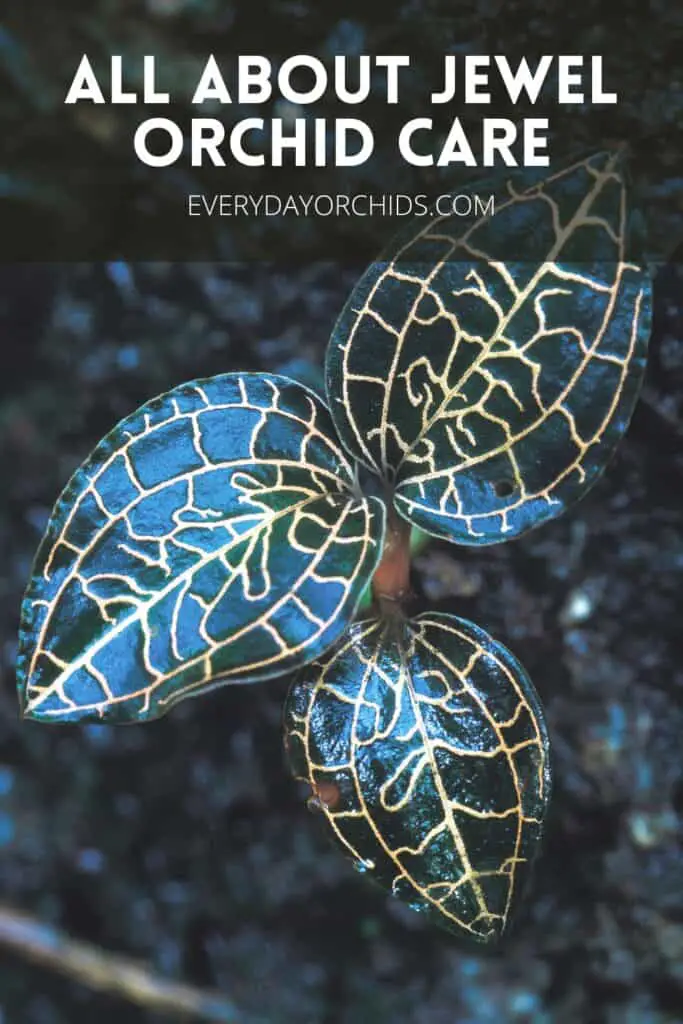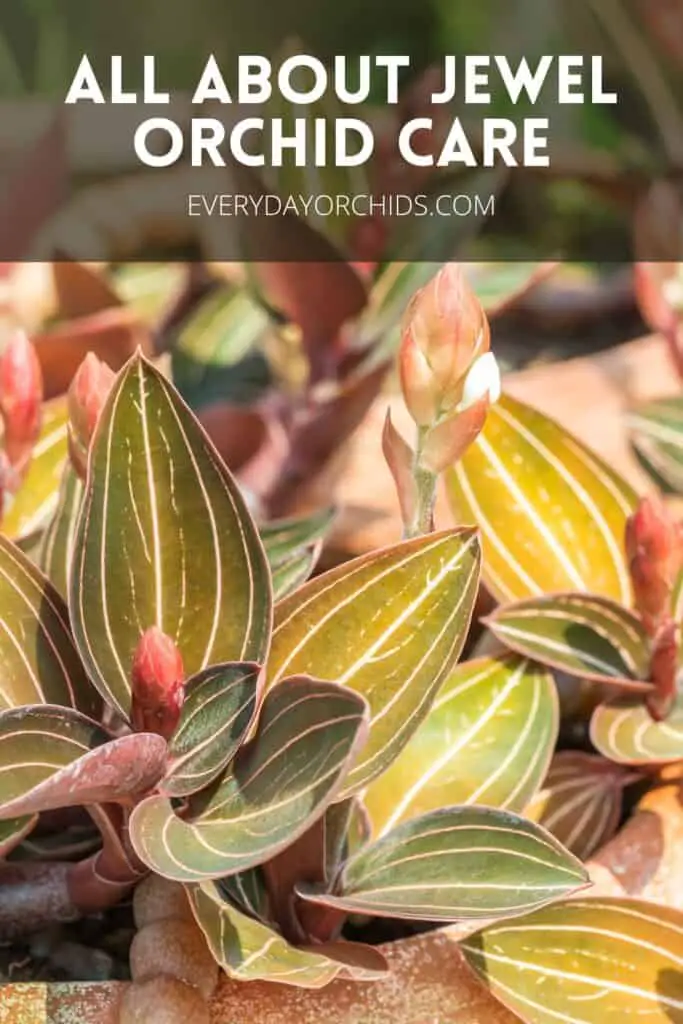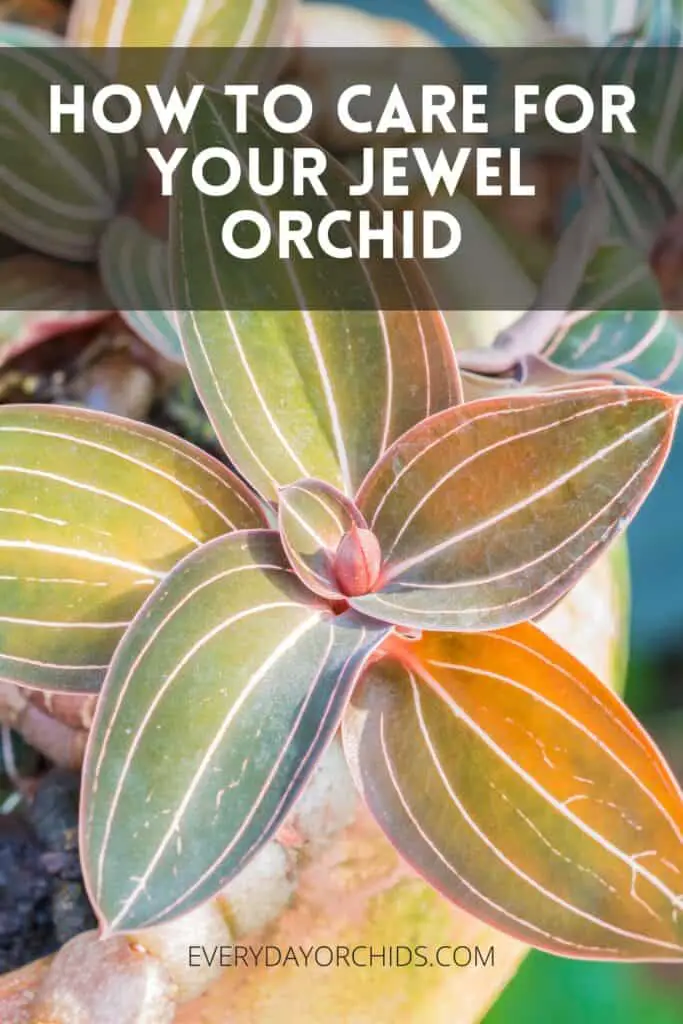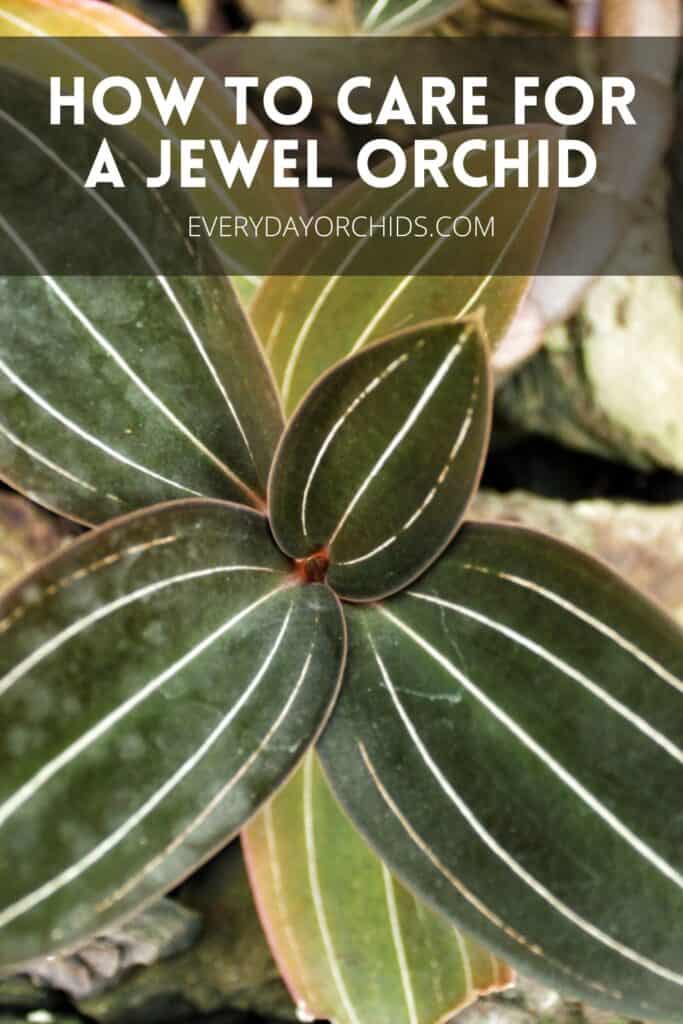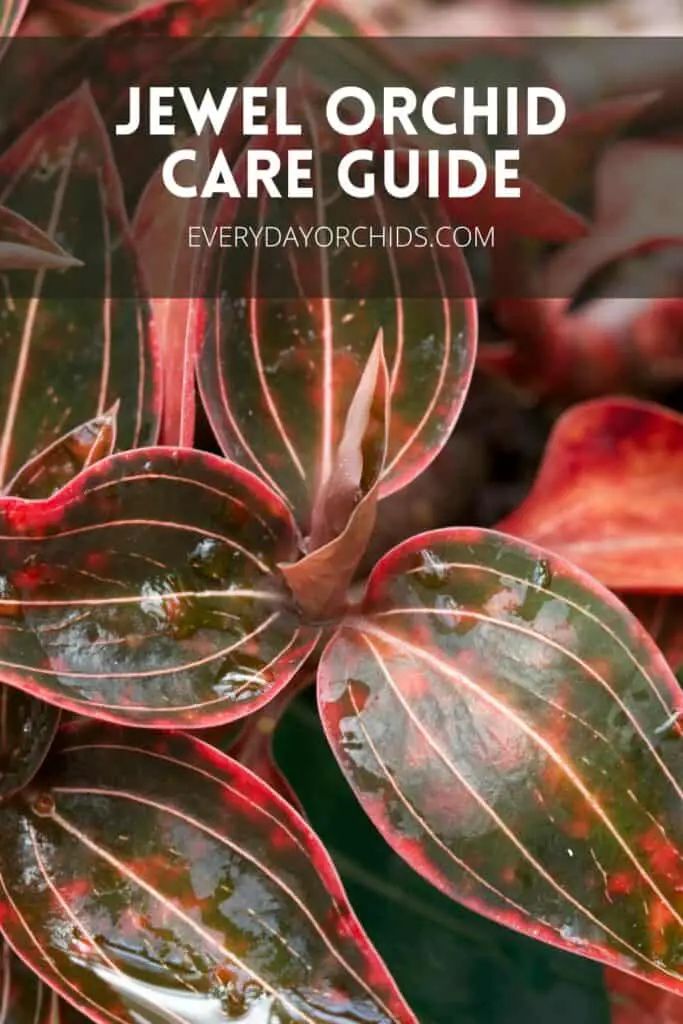Jewel orchids are prized by orchid growers and non-orchid growers alike for their unique and beautiful foliage. When it come to Jewel orchid care though, you may be at a loss for what to do. Don’t worry. While their care needs are slightly more complex than a regular houseplant, you can think of Jewel orchids as tropical houseplants and treat them accordingly.
Jewel orchids prefer low, but bright, indirect light, regular watering and high humidity levels. They thrive in tropical climates, so temperatures between 65-85 degrees Fahrenheit are most ideal. These terrestrial orchids can be planted in potting soil, as long as it is well-draining.
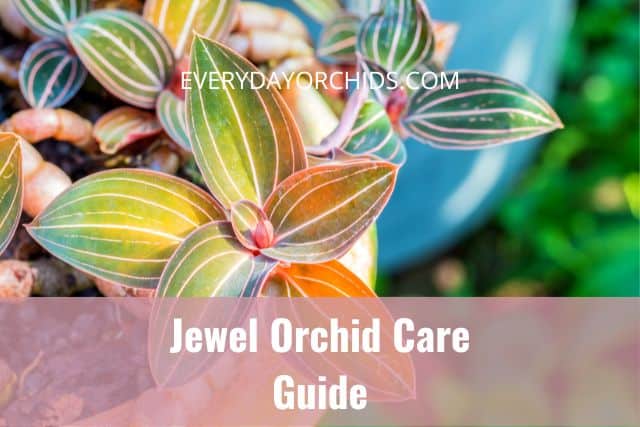
Do you have a Jewel orchid and are looking for some tips on how to care for it? Well, look no further.
In this article, I’ll go over the basics of Jewel orchid care in more detail, including lighting, watering, fertilization and humidity needs. I’ll also talk about how to pot and propagate your Jewel orchid, as well as go over some common problems you may encounter. Keep reading to learn more.
Please note that these links are affiliate links and as an Amazon Associate, I earn from qualifying purchases. Purchases made through affiliate links in this post may generate commissions at no additional cost to you. Use this link for a discounted Amazon Prime trial. Thank you for your support!
Table of Contents
Are Jewel Orchids Hard To Take Care Of?
A common misconception is that Jewel orchids are tricky to care for or have special needs because they look so different than other houseplants and orchids. The truth is, Jewel orchid care is fairly straightforward and easy.
If you are familiar with caring for Phalaenopsis orchids or tropical houseplants, you’ll find that the care requirements of Jewel orchids are quite similar.
One thing to note is that these are terrestrial orchids, meaning they are grown in soil or regular potting media. This is unlike Phalaenopsis orchids, which are epiphyte orchids.
Epiphyte orchids require special orchid bark for potting. I’ll talk more about this later, in the potting section below, but just know that Jewel orchids must be grown in soil rather than orchid bark.
Jewel orchids can be grown indoors in the home as a potted plant. They can also be grown outdoors if you live in a mild climate, or in a greenhouse with other plants, making them quite versatile.
These plants grow to be about 12-inches (1-foot) tall and about 12-inches (1-foot) wide. They take up a fairly small footprint wherever you plant them.
What Makes Jewel Orchids So Special?
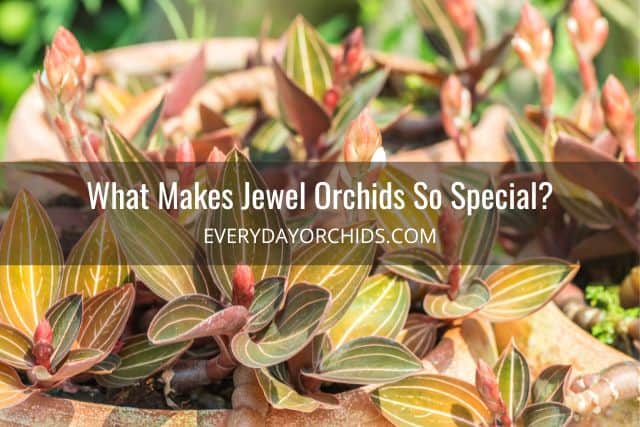
Jewel orchids are a type of orchid with uniquely patterned foliage. It is this foliage, rather than the flowers, which makes them attractive to plant lovers. Their soft, velvety patterned leaves are quite eye-catching and a great contrast to the green leaves of other orchid varieties.
Some Jewel orchids, such as the Ludisia Discolor Alba, have light green leaves with white veins. The Ludisica Discolor Nigrescens has dark maroon, almost black, leaves with pink veins. This orchid also goes by the name “Black Jewel Orchid.”
The Macodes petola and Macodes sanderiana Jewel orchids are known for their bright gold-toned veins running down the dark green leaves. These are sometimes called “Lightening Jewel orchids” due to the striking contrast between the bright neon gold color and dark green leaves. This variety of Jewel orchids prefers high humidity levels and does best in an enclosed terrarium.
Yet another Jewel orchid variety includes the Anoectochilus family of orchids. The Anoectochilus chapaensis, or “Golden Jewel orchid,” and Anoectochilus formosanus, or “Taiwan Jewel Orchid,” are two notable members. These have dark, almost black looking leaves with bright pink veining.
While there is variety within the Jewel orchid family, rest assured that the general care needs outlined below would apply.
Out of all the varieties mentioned above, I would say that the Ludisia variety of Jewel orchids is probably the easiest to start with. It can tolerate drying out better than the other varieties, though care should be taken not to let this happen too often. With regards to care, you can also approach Ludisia Jewel orchids similar to any other tropical houseplant.
Do Jewel Orchids Bloom?
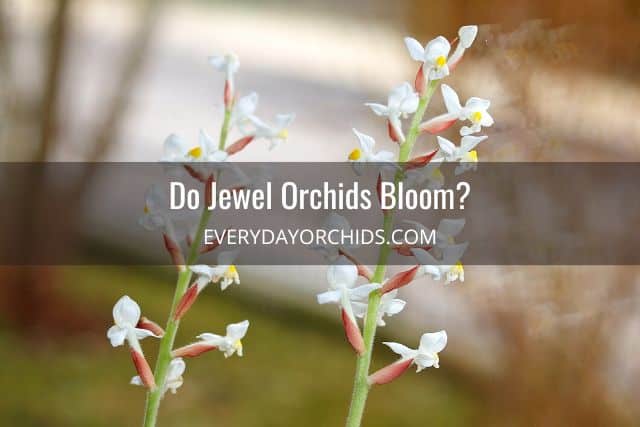
Yes, Jewel orchids do produce flowers, but this is not what makes them so popular. Instead, they are usually cultivated for their variegated and uniquely colored leaves.
The orchid blooms are usually a small cluster of white-colored or cream-colored flowers on a single flower stem. This flower stem emerges from the center of the Jewel orchid’s leaves, or the “crown” of the orchid.
You will need to stake these flowers for extra support, as the flower spikes can grow fairly long and make the orchid top-heavy. Use an orchid staking set such as this one to help support those long flower stalks.
Jewel orchids usually bloom once a year, either in the spring or autumn. The flowers last for 3 to 4 weeks before they start to fall off.
If you prefer to have a bushier plant and less flowers, you can pinch off or prune off the flower spike as soon as it starts to emerge. Doing so will encourage the Jewel orchid to produce more leaves.
Allowing your orchid to flower may lead to a leggier plant. However, a leggier Jewel orchid doesn’t look as nice. More importantly, as the plant becomes leggier, the stems become more prone to breakage.
Jewel Orchid Care: Temperature Tolerance
Jewel orchids are tropical plants. As a result, they do best in conditions that mimic their natural habitat.
These orchids tolerate a temperature range between 65-85 degrees Fahrenheit. They tend to do better in the upper part of that temperature range.
If you live in a warm, tropical climate, you can also grow these orchids outdoors. Just make sure that nighttime temps don’t drop below 60 degrees Fahrenheit.
They do not tolerate frost, so if you live in an area that experiences frost or nighttime temperatures below 60 degrees Fahrenheit, consider keeping these indoors or in a temperature-controlled greenhouse.
Jewel Orchid Care: Humidity Needs
These orchids love high humidity levels, between 50-70% humidity. This is not commonly found in most homes, where the usual humidity levels are around 30% or less.
You can increase humidity in your Jewel orchid’s growing space by using a humidifier or a humidity tray under the pot.
Grouping plants together in a growing area also has an effect of slightly raising ambient humidity levels. Just make sure you leave enough room between the pots for airflow and circulation.
Other options for keeping humidity levels high include growing these orchids in a terrarium (more on this below) or a greenhouse.
Jewel Orchid Problems Related To Humidity
While these orchids appreciate a high humidity level, be aware that very high humidity levels above 80% can be detrimental for your orchid. It can lead to increased fungal infections, rot, and decreased evaporation of existing water, which further increases the chances for rot.
Lighting Requirements Of Jewel Orchids
In their natural habitat, these orchids grow along the forest floor, shaded by the tree canopy. You’ll want to replicate similar lighting conditions for this orchid to help it thrive.
Choose a shaded location with low light to medium light. These orchids would do well near your Phalaenopsis orchids, if you have them.
North-facing windows would work well for this orchid. These windows tend to get less light than east-facing windows, just low levels of light, which would be perfect for your Jewel orchid. However, east-facing windows are also a great option.
If you plan to place these orchids near a west-facing or south-facing window, know that these windows might get more of the harsh afternoon sun. Use a thin curtain to reduce the light intensity hitting your orchid.
Jewel orchids can burn easily and you can avoid this by protecting it from the hot afternoon sun.
If you are growing these outdoors, choose a shaded location that still gets lots of bright, indirect light. Ideal locations would be under a canopy on your patio or under a tree. This way, the Jewel orchid is protected from the sun, but still can enjoy the filtered, dappled light coming through the canopy or tree branches.
Jewel Orchid Problems Related To Lighting
If your Jewel orchid’s leaves start to fade and lose their color, that can be a sign of overexposure to light. Try moving them to a lower light location and see if that stops the leaves from fading.
If your Jewel orchid becomes leggy without flowering, that means that it needs more light. In general, Ludisia Jewel orchids tend to do better than Macodes Jewel orchids in lower light conditions. To address the leggy orchid, try relocating it to a place with more light exposure, still taking care to avoid direct light.
If your home doesn’t receive a lot of natural lighting and you already have your orchid next to your brightest window, then consider using artificial lighting to supplement. Jewel orchids do really well under artificial lighting. You can read more about how to choose and set up artificial lighting for orchids here.
Watering Your Jewel Orchid
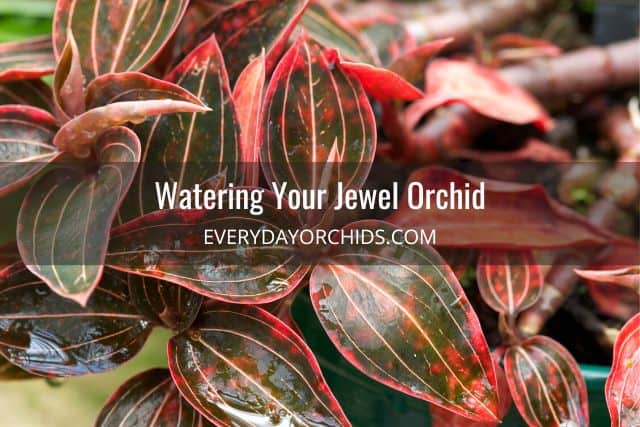
As with almost any orchid, you will want to water your Jewel orchid when the top layer of potting media is nearly dry. Do a finger test before watering and check the top layer of soil. If it is still damp or wet, wait another day or two and check again before watering.
When you do water your Jewel orchid, water evenly over the top layer of potting media. The roots are near surface level.
Watering frequency will vary depending on your climate, the temperature and the season. In hotter weather, your orchid will need more frequent watering, whereas in cooler weather, you can water less frequently. This is because it will take longer for the soil to dry out between waterings when temperatures are cool.
Always check the soil before watering and avoid watering your orchids on a schedule. This can go a long way in helping prevent problems related to over or underwatering. You can read more about how to water orchids here.
Jewel Orchid Problems Related To Watering
Avoid overwatering your Jewel orchid in order to prevent root rot from happening. If you notice that your Jewel orchid’s leaves are starting to turn yellow and fall off, you may be overwatering your orchid.
On the flip side, if your Jewel orchid’s leaves are starting to turn red and become limp, it may not be getting enough water. Don’t let your Jewel orchid dry out!
It is a fine balance between just enough water and too much or too little water for a Jewel orchid. Keep doing a finger test every few days until you get a better sense of how often and how much water your Jewel orchid needs.
Jewel Orchid Care: Fertilization
You can fertilize a Jewel orchid similar to how you would fertilize any other orchid.
Use a balanced orchid-specific fertilizer to feed your orchid at least twice a month during the growing season. Choose an orchid fertilizer with an NPK of 20-20-20, and ideally one that is urea-free.
Dilute the fertilizer before use to prevent root burn and over-fertilization problems. Follow this guide to fertilizing orchids here.
Potting A Jewel Orchid: Soil Needs
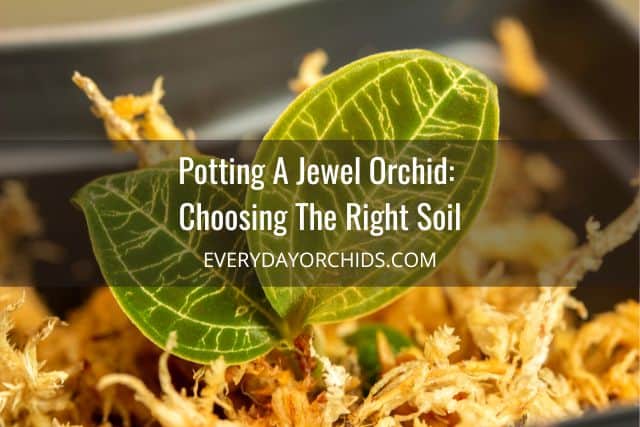
Jewel orchids are a type of terrestrial orchid, which means they grow best potted in soil. You don’t want to use orchid bark chips or orchid potting media for these plants.
Instead, Jewel orchids appreciate potting media with higher humidity and moisture content. There are several options in terms of what type of potting media to use for your Jewel orchid.
You can pot your Jewel orchid in either sphagnum moss or in a traditional potting soil mix containing peat and other organic material.
Another option is to buy one that’s ready made for Jewel orchids. For example, RepotMe sells a custom blend of potting mix geared towards Jewel orchids.
You can also make your own potting mix using a blend of coconut coir, peat and perlite in even ratios.
Potting mix designed for African violets also works well for Jewel orchids.
Another alternative is to buy a traditional terrestrial orchid potting mix, which usually has a blend of peat, perlite, and coconut coir.
The point is to use a well-draining, aerated potting mix that can also retain moisture.
Sphagnum Moss
If you plan to use sphagnum moss for your Jewel orchid, make sure you don’t pack in the moss too tightly around the roots. You want to allow breathing room for the roots and proper aeration.
Also, keep in mind that the innermost layers of moss may still be wet or damp while the outer layers of moss appear dry. Watering your orchid when the inner layer of moss is still wet can lead to root rot. Instead, try misting the outer layers of moss if they are dry.
Regular Potting Mix
Some orchid growers use regular potting soil for their Jewel orchids. They then care for them as they would with any other tropical plant. You can do this too, but just make sure that the soil is well-draining.
If you are planning on using regular potting mix for your Jewel orchid, I would recommend adding an extra couple handfuls of perlite or charcoal bits to the potting soil. This would allow for better drainage and aeration around the roots.
Repotting Your Jewel Orchid
In general, it is a good rule of thumb to repot your orchid every 1-2 years. Repotting is a routine part of Jewel orchid care.
When you see roots starting to come up out of the pot, it is time to repot your Jewel orchid.
If your orchid is growing in a pot, repotting it regularly allows you to change out the soil, inspect the roots and if needed, move the Jewel orchid to a slightly larger pot to allow for continued growth.
In terms of how to choose the right pot for your Jewel orchid, it is best to use a wide, shallow pot for this particular plant. Jewel orchids spread out as they grow and have shallow roots, so a wider pot, rather than a deeper pot, works best for this type of orchid.
Signs that your Jewel orchid needs to be repotted include yellowing leaves that fall off the plant, roots growing up and out of the soil, and a general appearance of being overcrowded.
Repotting your Jewel orchid is also an ideal time to divide, or propagate it. More on that in the section on propagation below.
If you are growing your Jewel orchid outdoors in the soil and not in a pot, then you don’t need to repot your orchid. Just make sure that it has room on both sides to continue to spread out and grow.
Growing Jewel Orchids In A Terrarium
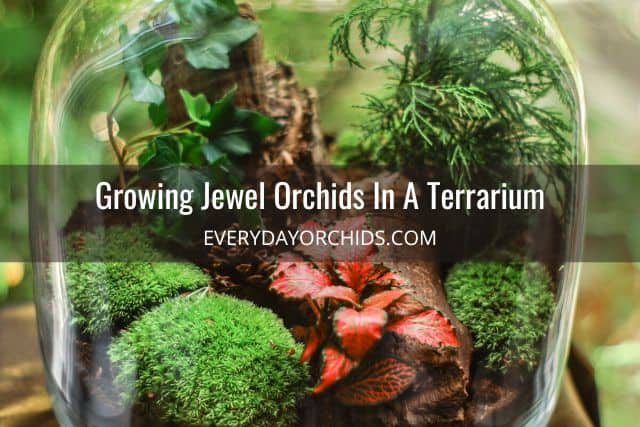
Jewel orchids are great candidates for growing in a terrarium due to their small size. They love the high humidity and moisture levels that a terrarium provides.
While in a terrarium, the potting media is able to stay evenly moist and humidity levels are easily maintained. You may be able to get away with watering your Jewel orchid less often due to the moisture that stays within the terrarium.
The fact that Jewel orchids are low light orchids also makes them a great candidate for terrariums. Out of all the different Jewel orchids out there, the Macodes petola and Macodes sanderiana Jewel orchids do best in terrariums.
Avoid These Terrarium Problems
While terrariums are great options for Jewel orchids, there are a few things you’ll need to do to keep your orchid healthy and happy.
If you keep your orchid in a closed terrarium, open the lid every so now and then for airflow. This will help prevent fungal infections and rot from taking hold.
When watering your orchid, avoid splashing water onto the leaves. Since the terrarium has a higher humidity level, it will take longer for any water to evaporate. A lack of air circulation combined with high humidity and moisture levels can easily lead to rot and fungal infections in your orchid.
In addition, you want to choose a wider terrarium to allow your orchid to grow out and to the sides. Otherwise, it could soon become too crowded and require you to replant your Jewel orchid sooner than anticipated.
Lastly, pinch off any flower spikes as they start to develop. These flower spikes can get fairly long and will eventually hit the top of the terrarium.
Allowing the flower spikes to grow will also cause the Jewel orchid to become leggy. If you are growing your Jewel orchid in a terrarium, you want to aim for a bushy, compact Jewel orchid rather than a tall, leggy one.
Jewel Orchid Care: Propagation
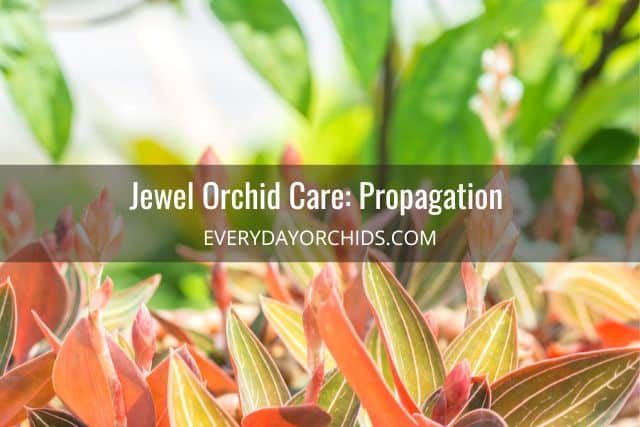
Jewel orchids can be propagated through cuttings or rhizome division when repotting. The stems of a Jewel orchid are actually pseudobulbs. Keep this in mind when you are trying to propagate your orchid.
If you are planning to divide the Jewel orchid along the rhizome during repotting, you’ll need a sharp, sterilized knife or gardening shears. Cut the Jewel orchid into sections, leaving each section with several stems with roots attached. Pot each division into a pot filled with your potting media of choice. Water well.
Propagation Via Cuttings
As for propagation through cuttings, this is similar to how you would take a cutting from a succulent or any other plant.
Simply take a 4-inch long cutting of a Jewel orchid stem using a pair of sharp, sterilized gardening shears. Cut below a node on the stem. You can either pot the cutting into a small pot filled with soil or try rooting it in water.
If you want to try rooting your cutting in water, simply place the cutting in a glass of water. Leave it in a place where it can receive lots of bright, indirect light. Change the water every few days and wait for roots to develop. It can take a few months before the roots are long enough and the Jewel orchid cutting is ready to be potted.
If you prefer not to root your cutting in water, you can also take a stem cutting and place it directly in a small pot filled with soil. Water it when the top layer of soil is nearly dry.
I would recommend staking the cutting for support during the first few months of growth. This is because the roots can take weeks or even months to develop. The extra support prevents the delicate roots from breaking due to the orchid getting jostled in the pot.
Jewel Orchid Problems: Pests And Disease
These orchids can be affected by the usual orchid pests. Most commonly scale can be a problem for Jewel orchids. If the potting media is overly wet, fungus gnats may also make an appearance. Mealybugs can also hide along the stems or on the undersides of the leaves. If dry conditions persist due to low humidity levels, spider mites may infest your Jewel orchid.
Root Rot
Root rot is the biggest problem for Jewel orchids. This is usually caused by overwatering and not allowing the top layer of potting soil to dry out between waterings.
You might notice root rot due to the presence of fungus gnats or orchid leaves quickly turning yellow and falling off.
Infections
Fungal and bacterial infections can also happen alongside root rot.
Brown spot and rot on the leaves can occur if the leaves get splashed with water and fail to dry out. To avoid this, try to water the roots and soil directly. Avoid overhead watering, as this results in splashing and can cause fungal spores in the soil to splash up onto the leaves.
If you do have any rot on the leaves or stem, use a pair of sterilized gardening shears to prune off the rotted parts of the orchid. Treat the rest of the orchid with fungicide, such as Physan20.
Moving forward, take care not to overwater your orchid. As mentioned above, always do a finger test of the top layer of potting media before watering and don’t water on a schedule.
Mold
Lastly, white mold on the potting media can happen if the potting media is kept damp with little to no air circulation around the pot.
If you spot mold in your Jewel orchid pot, you can remove just the moldy soil. However, if the mold is widespread, I would suggest repotting it into fresh potting media and using a new, sterilized pot.
Moving forward, make sure you only water when the top layer of potting soil is dry and maintain good air circulation around your orchids. This will go a long way in preventing the mold from coming back.
Final Thoughts
Jewel orchid care is similar enough to basic care needs of Phalaenopsis orchids and tropical houseplants. As a result, most anyone can grow these plants, as Jewel orchid care is not difficult. You just have to remember low light and high humidity are key for these terrestrial orchids.
Prized for their foilage rather than their flowers, Jewel orchids can add color and visual interest year-round. If you are looking to get your feet wet, start with the Ludisia variety of Jewel orchids. Good luck and happy orchid growing!
